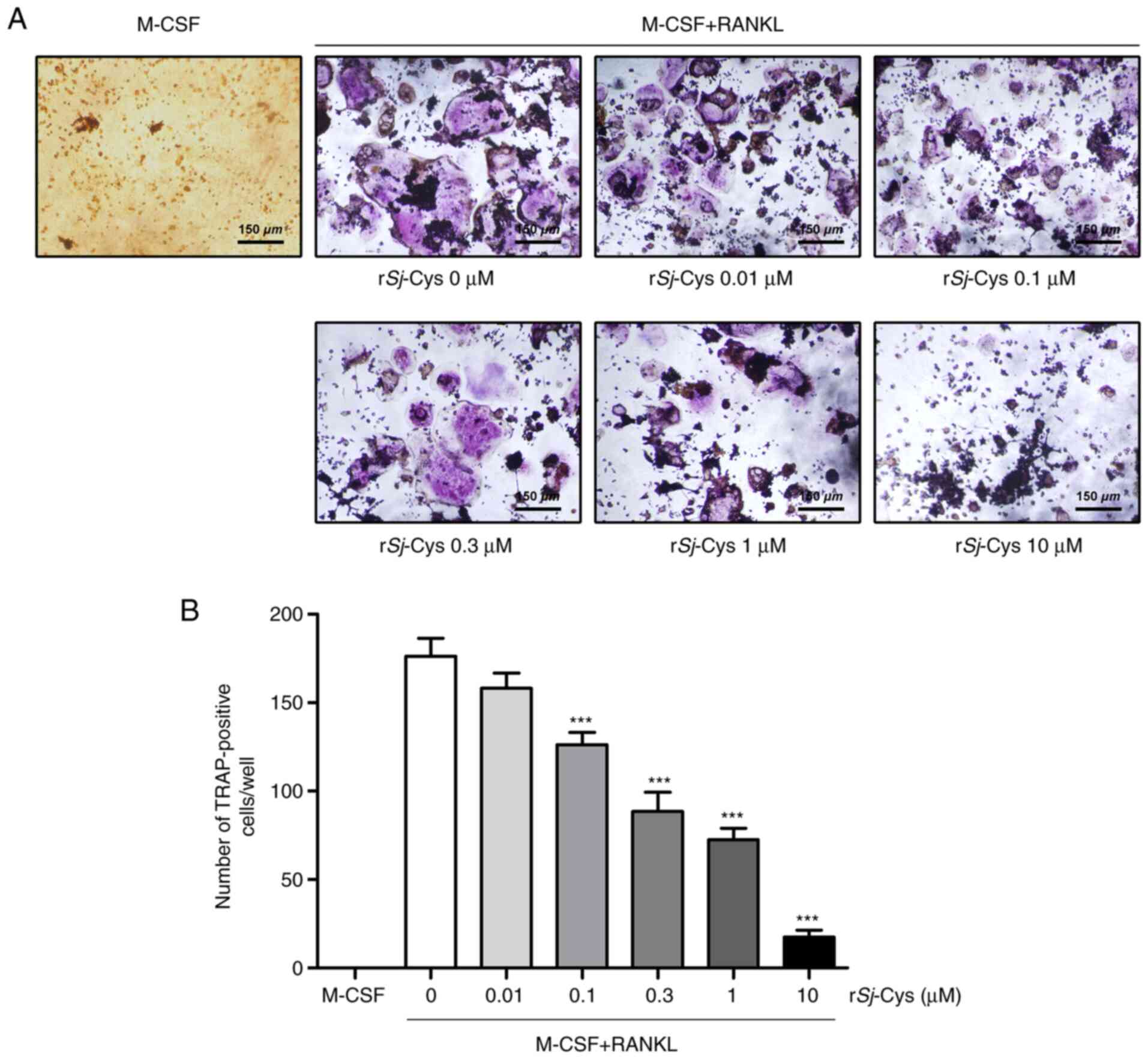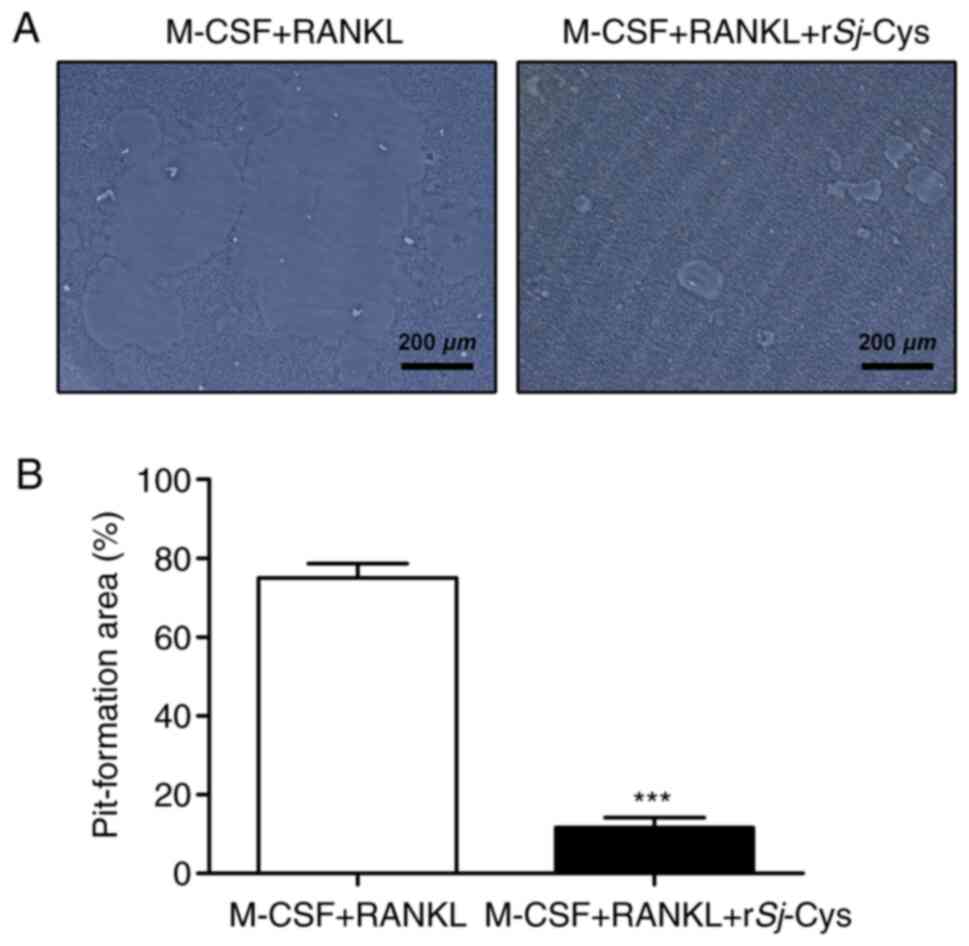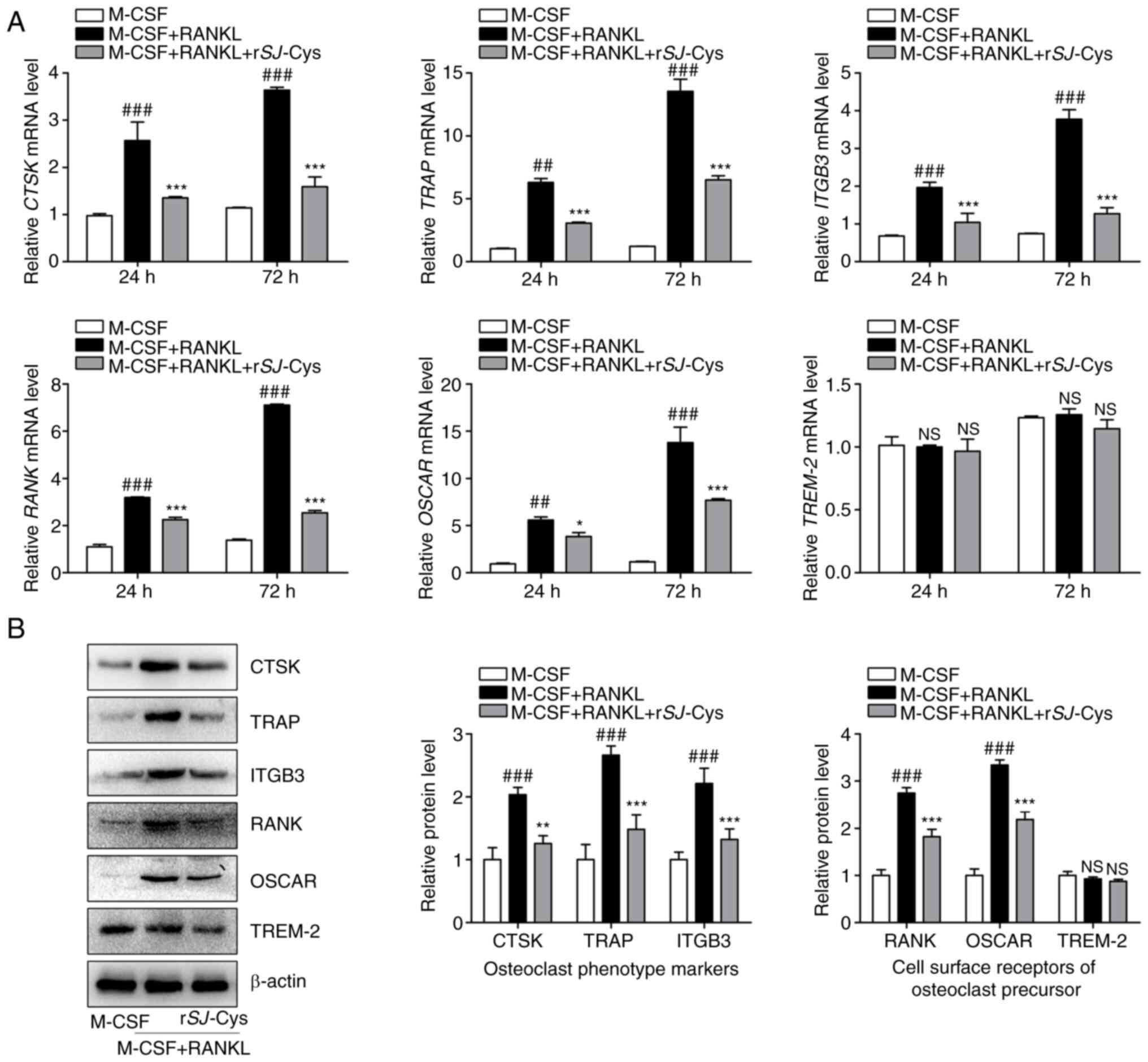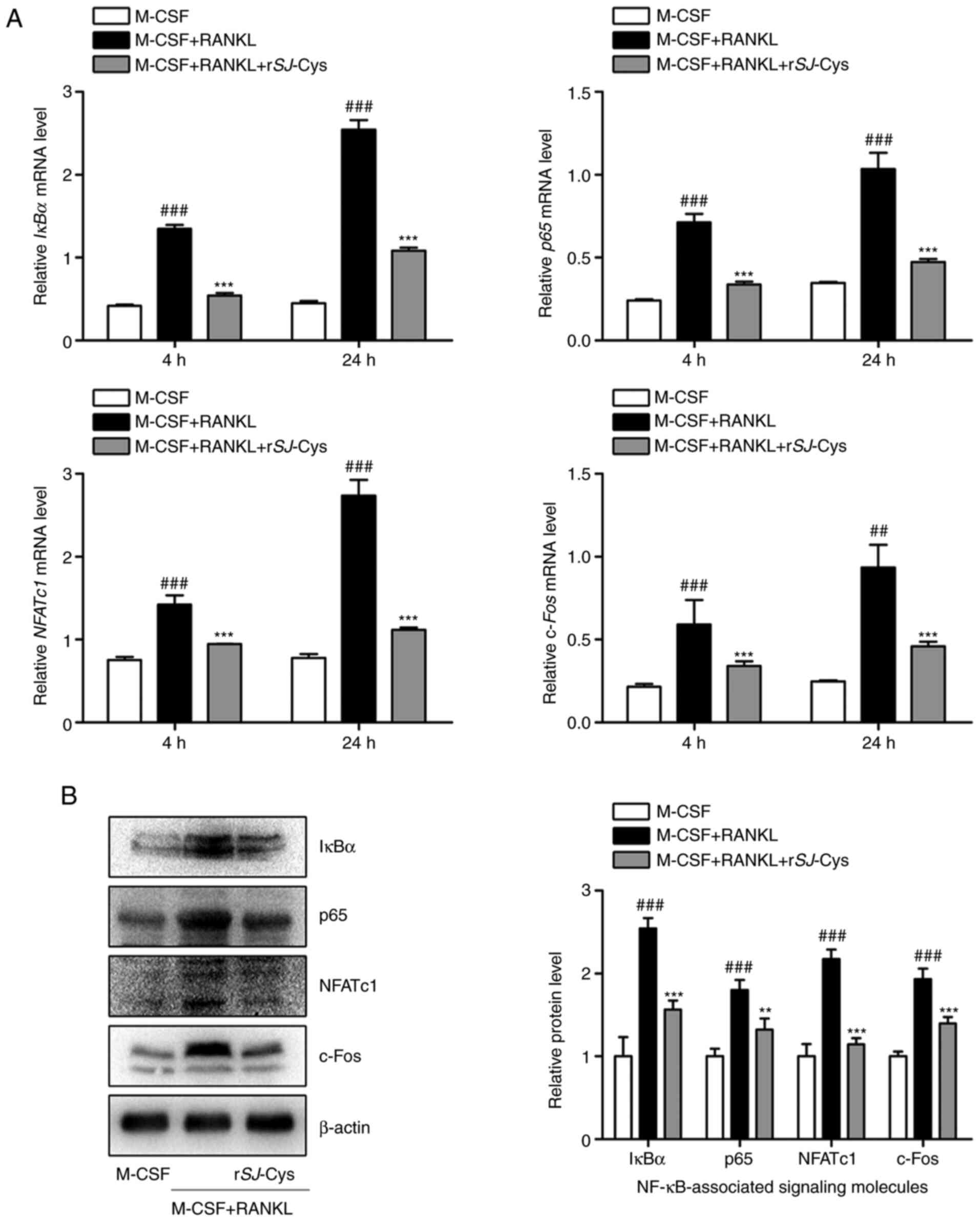|
1
|
Boyle WJ, Simonet WS and Lacey DL:
Osteoclast differentiation and activation. Nature. 423:337–342.
2003. View Article : Google Scholar : PubMed/NCBI
|
|
2
|
Ono T and Nakashima T: Recent advances in
osteoclast biology. Histochem Cell Biol. 149:325–341. 2018.
View Article : Google Scholar : PubMed/NCBI
|
|
3
|
Soysa NS, Alles N, Aoki K and Ohya K:
Osteoclast formation and differentiation: An overview. J Med Dent
Sci. 59:65–74. 2012.PubMed/NCBI
|
|
4
|
Okamoto K, Nakashima T, Shinohara M,
Negishi-Koga T, Komatsu N, Terashima A, Sawa S, Nitta T and
Takayanagi H: Osteoimmunology: The conceptual framework unifying
the immune and skeletal systems. Physiol Rev. 97:1295–1349. 2017.
View Article : Google Scholar : PubMed/NCBI
|
|
5
|
Asagiri M and Takayanagi H: The molecular
understanding of osteoclast differentiation. Bone. 40:251–264.
2007. View Article : Google Scholar : PubMed/NCBI
|
|
6
|
Park JH, Lee NK and Lee SY: Current
understanding of RANK signaling in osteoclast differentiation and
maturation. Mol Cells. 40:706–713. 2017.PubMed/NCBI
|
|
7
|
Feng X: RANKing intracellular signaling in
osteoclasts. IUBMB Life. 57:389–395. 2005. View Article : Google Scholar : PubMed/NCBI
|
|
8
|
Zhao Q, Shao J, Chen W and Li YP:
Osteoclast differentiation and gene regulation. Front Biosci.
12:2519–2529. 2007. View
Article : Google Scholar : PubMed/NCBI
|
|
9
|
Teitelbaum SL: Bone resorption by
osteoclasts. Science. 289:1504–1508. 2000. View Article : Google Scholar : PubMed/NCBI
|
|
10
|
Gruber R: Molecular and cellular basis of
bone resorption. Wien Med Wochenschr. 165:48–53. 2015. View Article : Google Scholar : PubMed/NCBI
|
|
11
|
Delaissé JM, Andersen TL, Engsig MT,
Henriksen K, Troen T and Blavier L: Matrix metalloproteinases (MMP)
and cathepsin K contribute differently to osteoclastic activities.
Microsc Res Tech. 61:504–513. 2003. View Article : Google Scholar : PubMed/NCBI
|
|
12
|
Troen BR: The role of cathepsin K in
normal bone resorption. Drug News Perspect. 17:19–28. 2004.
View Article : Google Scholar : PubMed/NCBI
|
|
13
|
Arman A, Bereket A, Coker A, Kiper PÖ,
Güran T, Ozkan B, Atay Z, Akçay T, Haliloglu B, Boduroglu K, et al:
Cathepsin K analysis in a pycnodysostosis cohort: Demographic,
genotypic and phenotypic features. Orphanet J Rare Dis. 9:602014.
View Article : Google Scholar : PubMed/NCBI
|
|
14
|
Lazner F, Gowen M and Kola I: An animal
model for pycnodysostosis: The role of cathepsin K in bone
remodelling. Mol Med Today. 5:413–414. 1999. View Article : Google Scholar : PubMed/NCBI
|
|
15
|
Khatri V, Chauhan N and Kalyanasundaram R:
Parasite cystatin: Immunomodulatory molecule with therapeutic
activity against immune mediated disorders. Pathogens. 9:4312020.
View Article : Google Scholar
|
|
16
|
Ochieng J and Chaudhuri G: Cystatin
superfamily. J Health Care Poor Underserved. 21 (Suppl 1):S51–S70.
2010. View Article : Google Scholar
|
|
17
|
Abrahamson M, Alvarez-Fernandez M and
Nathanson CM: Cystatins. Biochem Soc Symp. 70:179–199. 2003.
View Article : Google Scholar
|
|
18
|
Leto G, Crescimanno M and Flandina C: On
the role of cystatin C in cancer progression. Life Sci.
202:152–160. 2018. View Article : Google Scholar : PubMed/NCBI
|
|
19
|
Brage M, Abrahamson M, Lindström V, Grubb
A and Lerner UH: Different cysteine proteinases involved in bone
resorption and osteoclast formation. Calcif Tissue Int. 76:439–447.
2005. View Article : Google Scholar : PubMed/NCBI
|
|
20
|
Breznik B, Mitrović A, T Lah T and Kos J:
Cystatins in cancer progression: More than just cathepsin
inhibitors. Biochimie. 166:233–250. 2019. View Article : Google Scholar : PubMed/NCBI
|
|
21
|
Yang X, Liu J, Yue Y, Chen W, Song M, Zhan
X and Wu Z: Cloning, expression and characterisation of a type II
cystatin from Schistosoma japonicum, which could regulate
macrophage activation. Parasitol Res. 113:3985–3992. 2014.
View Article : Google Scholar : PubMed/NCBI
|
|
22
|
Li H, Wang S, Zhan B, He W, Chu L, Qiu D,
Li N, Wan Y, Zhang H, Chen X, et al: Therapeutic effect of
Schistosoma japonicum cystatin on bacterial sepsis in mice.
Parasit Vectors. 10:2222017. View Article : Google Scholar : PubMed/NCBI
|
|
23
|
He B, Cai G, Ni Y, Li Y, Zong H and He L:
Characterization and expression of a novel cystatin gene from
Schistosoma japonicum. Mol Cell Probes. 25:186–193. 2011.
View Article : Google Scholar : PubMed/NCBI
|
|
24
|
Lehesjoki AE: Molecular background of
progressive myoclonus epilepsy. EMBO J. 22:3473–3478. 2003.
View Article : Google Scholar : PubMed/NCBI
|
|
25
|
Lecaille F, Brömme D and Lalmanach G:
Biochemical properties and regulation of cathepsin K activity.
Biochimie. 90:208–226. 2008. View Article : Google Scholar : PubMed/NCBI
|
|
26
|
Laitala-Leinonen T, Rinne R, Saukko P,
Väänänen HK and Rinne A: Cystatin B as an intracellular modulator
of bone resorption. Matrix Biol. 25:149–157. 2006. View Article : Google Scholar : PubMed/NCBI
|
|
27
|
Gao S, Li H, Xie H, Wu S, Yuan Y, Chu L,
Sun S, Yang H, Wu L, Bai Y, et al: Therapeutic efficacy of
Schistosoma japonicum cystatin on sepsis-induced
cardiomyopathy in a mouse model. Parasit Vectors. 13:2602020.
View Article : Google Scholar : PubMed/NCBI
|
|
28
|
Livak KJ and Schmittgen TD: Analysis of
relative gene expression data using real-time quantitative PCR and
the 2(-Delta Delta C(T)) method. Methods. 25:402–408. 2001.
View Article : Google Scholar : PubMed/NCBI
|
|
29
|
Wilson SR, Peters C, Saftig P and Brömme
D: Cathepsin K activity-dependent regulation of osteoclast actin
ring formation and bone resorption. J Biol Chem. 284:2584–2592.
2009. View Article : Google Scholar : PubMed/NCBI
|
|
30
|
Goto T, Yamaza T and Tanaka T: Cathepsins
in the osteoclast. J Electron Microsc (Tokyo). 52:551–518. 2003.
View Article : Google Scholar : PubMed/NCBI
|
|
31
|
Klotz C, Ziegler T, Daniłowicz-Luebert E
and Hartmann S: Cystatins of parasitic organisms. Adv Exp Med Biol.
712:208–221. 2011. View Article : Google Scholar : PubMed/NCBI
|
|
32
|
Hayman AR: Tartrate-resistant acid
phosphatase (TRAP) and the osteoclast/immune cell dichotomy.
Autoimmunity. 41:218–223. 2008. View Article : Google Scholar : PubMed/NCBI
|
|
33
|
Tanaka S, Miyazaki T, Fukuda A, Akiyama T,
Kadono Y, Wakeyama H, Kono S, Hoshikawa S, Nakamura M, Ohshima Y,
et al: Molecular mechanism of the life and death of the osteoclast.
Ann N Y Acad Sci. 1068:180–186. 2006. View Article : Google Scholar : PubMed/NCBI
|
|
34
|
Tanaka S, Wakeyama H, Akiyama T, Takahashi
K, Amano H, Nakayama KI and Nakamura K: Regulation of osteoclast
apoptosis by Bcl-2 family protein Bim and Caspase-3. Adv Exp Med
Biol. 658:111–116. 2010. View Article : Google Scholar : PubMed/NCBI
|
|
35
|
Boyce BF, Xiu Y, Li J, Xing L and Yao Z:
NF-κB-mediated regulation of osteoclastogenesis. Endocrinol Metab
(Seoul). 30:35–44. 2015. View Article : Google Scholar : PubMed/NCBI
|
|
36
|
Vallabhapurapu S and Karin M: Regulation
and function of NF-kappaB transcription factors in the immune
system. Annu Rev Immunol. 27:693–733. 2009. View Article : Google Scholar : PubMed/NCBI
|



















